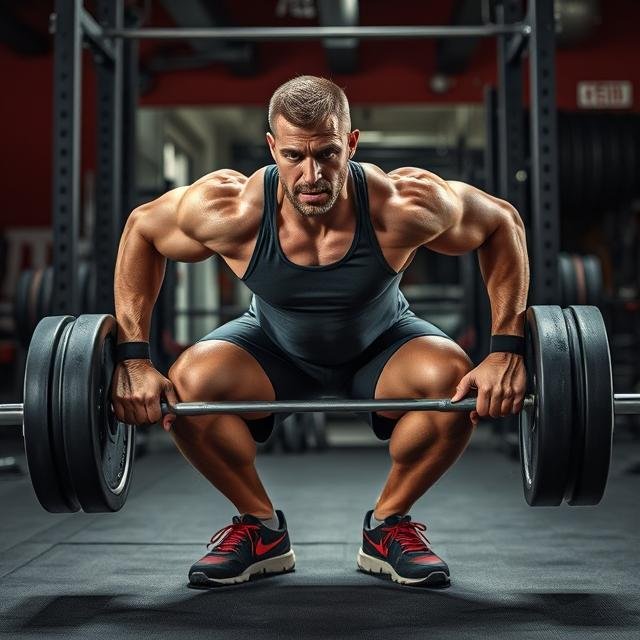
Full body workouts
Full body workouts are comprehensive training routines that engage all the major muscle groups in a single session, including the upper body, lower body, and core. These workouts are highly efficient for building overall strength, improving cardiovascular fitness, and burning calories, making them ideal for those with limited time or looking for balanced muscle development. Exercises like squats, push-ups, deadlifts, and rows are commonly included to ensure a complete and functional workout. Full body training also promotes better muscle coordination and recovery, especially when performed two to three times per week. Whether you’re a beginner or an experienced athlete, full body workouts can be easily customized to match your fitness level and goals.
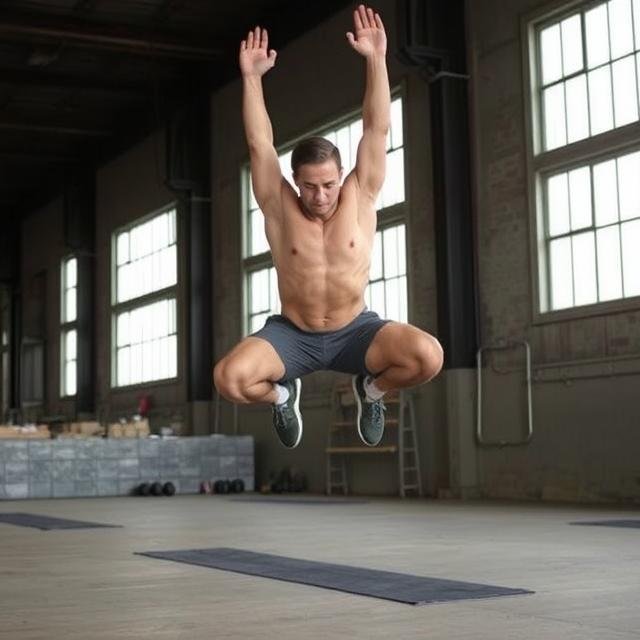
Burpee
Here are several types of burpees that can add variety to your workout routine:
1. Standard Burpee
- Muscles Targeted: Full-body (legs, core, chest, arms).
- How to Perform:
- Start standing, squat down, place your hands on the floor, jump your feet back into a plank position, perform a push-up, jump your feet forward, and explode up into a jump.
- Start standing, squat down, place your hands on the floor, jump your feet back into a plank position, perform a push-up, jump your feet forward, and explode up into a jump.
2. Modified Burpee (Beginners)
- Muscles Targeted: Full-body (light emphasis on core and arms).
- How to Perform:
- This version removes the push-up or jump. You squat down, walk your feet back into a plank, walk them forward, and then stand up. You can also remove the jump.
- This version removes the push-up or jump. You squat down, walk your feet back into a plank, walk them forward, and then stand up. You can also remove the jump.
3. Burpee with Push-Up
- Muscles Targeted: Chest, arms, core, legs.
- How to Perform:
- Perform a regular burpee, but add a push-up when you reach the plank position. This increases the upper body challenge.
- Perform a regular burpee, but add a push-up when you reach the plank position. This increases the upper body challenge.
4. Burpee with Tuck Jump
- Muscles Targeted: Full-body (focus on legs and core).
- How to Perform:
- After performing the standard burpee, instead of just jumping up, pull your knees towards your chest in a tuck jump.
- After performing the standard burpee, instead of just jumping up, pull your knees towards your chest in a tuck jump.
5. Box Jump Burpee
- Muscles Targeted: Full-body (legs, core, and explosive power).
- How to Perform:
- Perform a standard burpee, but instead of jumping vertically into the air, jump onto a box (or elevated surface) when you reach the “jump” phase. It targets the legs more.
- Perform a standard burpee, but instead of jumping vertically into the air, jump onto a box (or elevated surface) when you reach the “jump” phase. It targets the legs more.
6. Burpee Broad Jump
- Muscles Targeted: Full-body (focus on legs and core).
- How to Perform:
- Instead of a vertical jump, perform a broad jump (jump forward as far as possible) after completing the regular burpee. This variation focuses on the explosive strength of your legs.
- Instead of a vertical jump, perform a broad jump (jump forward as far as possible) after completing the regular burpee. This variation focuses on the explosive strength of your legs.
7. Double Burpee
- Muscles Targeted: Full-body (legs, chest, core).
- How to Perform:
- Complete a standard burpee, but instead of one jump, do two. After jumping up from the burpee, go straight into a second jump and land back into the squat position to perform another burpee.
- Complete a standard burpee, but instead of one jump, do two. After jumping up from the burpee, go straight into a second jump and land back into the squat position to perform another burpee.
8. Half Burpee
- Muscles Targeted: Core, chest, arms, legs.
- How to Perform:
- Instead of jumping your feet back into a full plank, step one leg back at a time, then step them forward, and jump straight up. This is a low-impact version of the traditional burpee.
- Instead of jumping your feet back into a full plank, step one leg back at a time, then step them forward, and jump straight up. This is a low-impact version of the traditional burpee.
9. Single-Leg Burpee
- Muscles Targeted: Full-body (legs, arms, core).
- How to Perform:
- Perform a regular burpee but keep one leg elevated throughout the exercise. Alternate legs to challenge balance and stability.
- Perform a regular burpee but keep one leg elevated throughout the exercise. Alternate legs to challenge balance and stability.
10. Burpee with Knee to Elbow
- Muscles Targeted: Core, chest, arms, legs.
- How to Perform:
- After jumping your feet back into plank position, bring one knee towards the opposite elbow. This variation activates your obliques and core even more.
- After jumping your feet back into plank position, bring one knee towards the opposite elbow. This variation activates your obliques and core even more.
11. Over-the-Box Burpee
- Muscles Targeted: Full-body (focus on legs, core, and explosiveness).
- How to Perform:
- Perform a standard burpee, but instead of jumping straight up, jump over an object (like a box or bench) as you complete the jump phase.
- Perform a standard burpee, but instead of jumping straight up, jump over an object (like a box or bench) as you complete the jump phase.
12. Burpee with Lateral Jump
- Muscles Targeted: Core, legs, arms.
- How to Perform:
- After completing the burpee, instead of jumping straight up, jump sideways (laterally) as far as you can. This helps target your hip abductors and works the legs in a different way.
- After completing the burpee, instead of jumping straight up, jump sideways (laterally) as far as you can. This helps target your hip abductors and works the legs in a different way.
13. Handstand Burpee
- Muscles Targeted: Core, shoulders, chest, arms.
- How to Perform:
- Perform a standard burpee, but after jumping your feet back into the plank position, kick up into a handstand before coming down and completing the burpee jump.
- Perform a standard burpee, but after jumping your feet back into the plank position, kick up into a handstand before coming down and completing the burpee jump.
14. Burpee with Dumbbells (or Kettlebells)
- Muscles Targeted: Full-body (focus on arms, chest, legs).
- How to Perform:
- Hold a dumbbell or kettlebell in each hand during the burpee. Perform the exercise as usual, but with the added weight to increase the intensity, especially on the arms, chest, and shoulders.
- Hold a dumbbell or kettlebell in each hand during the burpee. Perform the exercise as usual, but with the added weight to increase the intensity, especially on the arms, chest, and shoulders.
15. Suicide Burpee
- Muscles Targeted: Full-body (focus on legs and cardio).
- How to Perform:
- After completing the standard burpee, instead of just jumping up, sprint forward for 10-20 meters before returning to your starting position and performing the next burpee.
- After completing the standard burpee, instead of just jumping up, sprint forward for 10-20 meters before returning to your starting position and performing the next burpee.
Tips for Burpee Variations:
- Focus on maintaining proper form, especially in the push-up and plank positions.
- Start slow and work your way up to higher intensity or more advanced variations as you build strength and endurance.
- Burpees are challenging, so listen to your body to avoid injury and adjust the intensity as needed.
Incorporating different burpee variations into your workout routine can help you target more muscle groups, improve your overall conditioning, and keep your workouts interesting.
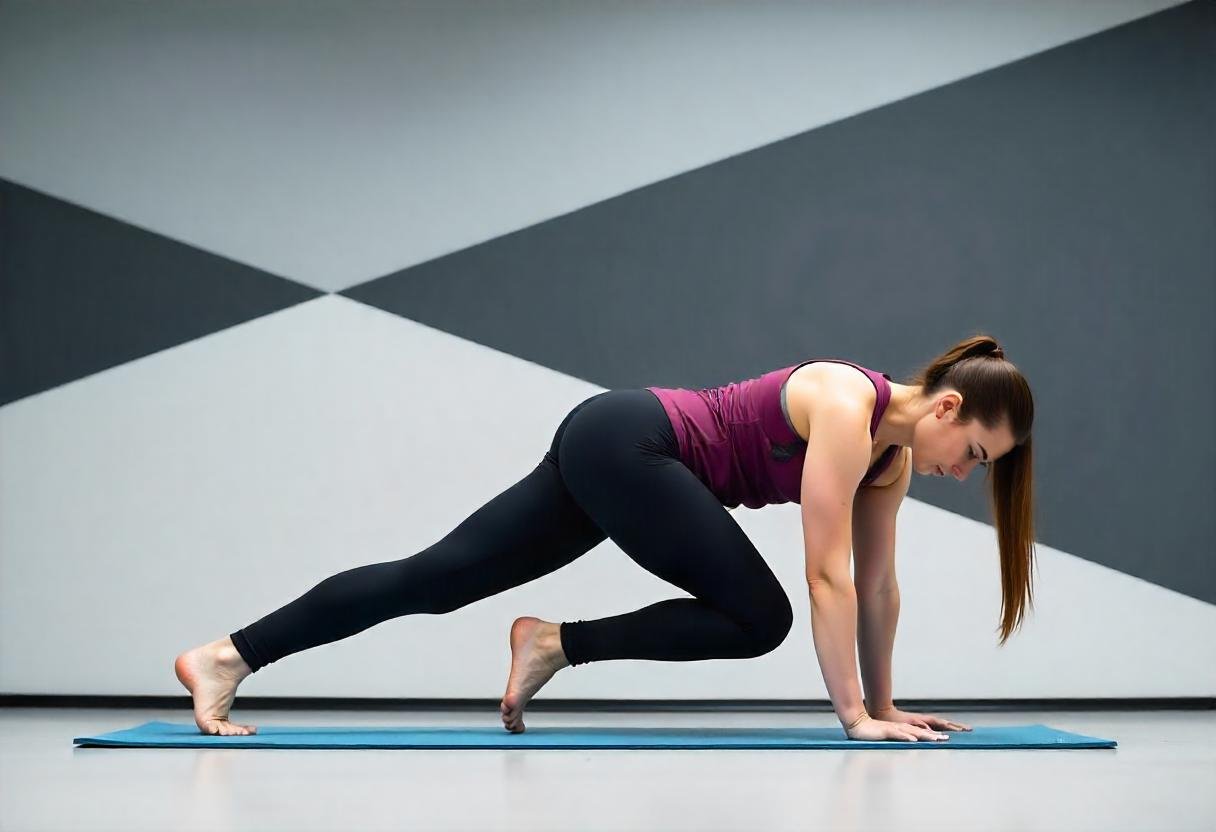
Mountain Climbers
Mountain climbers are a high-intensity, full-body exercise that primarily targets the core while also engaging the shoulders, chest, and legs. Performed in a plank position, the movement involves rapidly driving the knees toward the chest in an alternating fashion, mimicking a running motion. This exercise not only builds core strength and stability but also boosts cardiovascular endurance, coordination, and agility. Mountain climbers are a popular choice in circuit training and HIIT workouts due to their ability to elevate heart rate quickly and burn calories efficiently. Proper form—keeping the hips low and back flat—is essential to maximize benefits and prevent injury.
Here are several variations of burpees for your workout routine
A great full-body exercise that engages your core, legs, and arms.
1. Standard Mountain Climbers
- Muscles Targeted: Core, shoulders, chest, arms, quads.
- How to Perform:
- Start in a high plank position with your hands directly under your shoulders and your body forming a straight line from head to heels.
- Bring one knee towards your chest, then quickly switch legs, driving the other knee forward as the first leg returns to the starting position.
- Continue alternating legs rapidly, keeping your hips stable.
- Start in a high plank position with your hands directly under your shoulders and your body forming a straight line from head to heels.
2. Cross-Body Mountain Climbers
- Muscles Targeted: Core (especially obliques), shoulders, arms, quads.
- How to Perform:
- Begin in the high plank position.
- Drive one knee towards the opposite elbow (right knee to left elbow, left knee to right elbow).
- Alternate legs in a controlled, fast pace, engaging your obliques and core.
- Begin in the high plank position.
3. Slow Mountain Climbers
- Muscles Targeted: Core, shoulders, legs.
- How to Perform:
- Perform mountain climbers, but at a much slower pace.
- Focus on keeping your body straight, tightening your core, and controlling each movement as you bring your knee towards your chest.
- This version increases the time under tension, making it great for building strength.
- Perform mountain climbers, but at a much slower pace.
4. Mountain Climbers with a Twist
- Muscles Targeted: Core (obliques), shoulders, arms, quads.
- How to Perform:
- Start in the high plank position.
- Bring one knee towards your chest, but twist your torso so the knee crosses towards the opposite side of your body (e.g., right knee towards left elbow).
- Alternate sides, engaging your obliques as you twist with each leg movement.
- Start in the high plank position.
5. Plank Mountain Climbers
- Muscles Targeted: Core, shoulders, arms, quads, glutes.
- How to Perform:
- Start in a low plank position (on forearms), making sure your body forms a straight line from head to heels.
- Alternate driving your knees towards your chest quickly, keeping your core engaged to prevent your hips from rising or sagging.
- Start in a low plank position (on forearms), making sure your body forms a straight line from head to heels.
6. Spider Mountain Climbers
- Muscles Targeted: Core, chest, shoulders, legs.
- How to Perform:
- Begin in the high plank position.
- Bring your right knee out to the side towards your right elbow, then quickly switch legs, bringing your left knee out to the side towards your left elbow.
- This variation engages your obliques and hip abductors while also activating the core.
- Begin in the high plank position.
7. Mountain Climbers with Push-Up
- Muscles Targeted: Core, chest, arms, shoulders, quads.
- How to Perform:
- Start in a high plank position.
- Perform one push-up, and then immediately do 10-15 mountain climbers (alternating legs).
- Continue this circuit for a set time or number of repetitions.
- Start in a high plank position.
8. Jumping Mountain Climbers
- Muscles Targeted: Core, arms, legs (explosive power).
- How to Perform:
- Start in the high plank position.
- Instead of alternating your knees slowly, jump both feet off the floor and bring your knees towards your chest quickly.
- This explosive movement increases the intensity and adds a cardio element to the exercise.
- Start in the high plank position.
9. Mountain Climbers with a Leg Hold
- Muscles Targeted: Core, shoulders, arms, legs.
- How to Perform:
- Perform standard mountain climbers, but at the top of each movement, hold one knee in the “chest” position for a couple of seconds before switching legs.
- This variation emphasizes the contraction and stability of the core and legs.
- Perform standard mountain climbers, but at the top of each movement, hold one knee in the “chest” position for a couple of seconds before switching legs.
10. Mountain Climbers with Resistance Band
- Muscles Targeted: Core, shoulders, legs, arms.
- How to Perform:
- Secure a resistance band around your feet while in the high plank position.
- Perform mountain climbers as usual, but the resistance band will increase the difficulty, especially when driving the legs forward.
- Secure a resistance band around your feet while in the high plank position.
Tips for Proper Form:
- Maintain a straight body line from head to heels.
- Keep your hands directly under your shoulders.
- Keep your core tight throughout the movement to prevent sagging or lifting your hips.
- Perform the movements quickly but with control to maximize the benefits and avoid injury.
Benefits of Mountain Climber Variations:
- Engages multiple muscle groups, especially the core.
- Increases cardiovascular endurance.
- Improves coordination and stability.
- Can be modified for different fitness levels.
Incorporating different mountain climber variations into your workouts will challenge your muscles in new ways, improve your cardiovascular fitness, and keep things interesting.
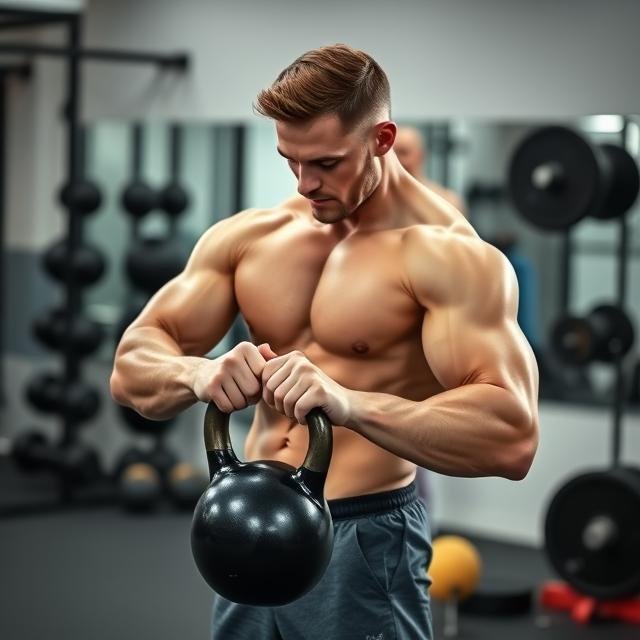
Kettle-bell swing
The kettlebell swing is a powerful and dynamic exercise that targets the posterior chain, including the glutes, hamstrings, lower back, and core, while also improving cardiovascular fitness. Performed by swinging a kettlebell between the legs and then driving it forward to chest height using a hip hinge motion, the movement relies on explosive hip thrusts rather than arm strength. This makes it highly effective for building strength, endurance, and power. Kettlebell swings also help enhance posture and functional movement, making them a staple in many strength and conditioning programs. Proper technique and control are crucial to avoid strain and maximize the benefits of this full-body exercise.
kettlebell swing variations
Strength, cardiovascular endurance, targeting the core, glutes, and legs.
1. Standard Kettlebell Swing
- Muscles Targeted: Glutes, hamstrings, lower back, core, shoulders
- How to Perform:
- Stand with your feet shoulder-width apart and the kettlebell on the floor in front of you.
- Hinge at the hips, not the knees, and grab the kettlebell handle with both hands.
- Swing the kettlebell backward between your legs, keeping your back straight and chest up.
- Drive through your hips, explosively thrusting them forward, and swing the kettlebell to chest height (eye level).
- Control the kettlebell back down and repeat the movement.
- Stand with your feet shoulder-width apart and the kettlebell on the floor in front of you.
2. American Kettlebell Swing
- Muscles Targeted: Glutes, hamstrings, shoulders, core
- How to Perform:
- This variation is similar to the standard swing but with a higher range of motion.
- Swing the kettlebell overhead (over the head, not just to eye level).
- Focus on maintaining good posture and engaging your core to prevent any strain on the lower back.
- Be cautious of your shoulder flexibility and range of motion.
- This variation is similar to the standard swing but with a higher range of motion.
3. Russian Kettlebell Swing
- Muscles Targeted: Glutes, hamstrings, lower back, core, shoulders
- How to Perform:
- This is a more traditional kettlebell swing, where the kettlebell swings to shoulder height (rather than overhead as in the American Swing).
- It focuses more on the posterior chain (glutes, hamstrings, lower back) while still engaging the core and shoulders.
- Keep your core tight, hips back, and focus on the hip thrust to power the movement.
- This is a more traditional kettlebell swing, where the kettlebell swings to shoulder height (rather than overhead as in the American Swing).
4. One-Arm Kettlebell Swing
- Muscles Targeted: Core, glutes, hamstrings, shoulders, forearms
- How to Perform:
- Perform the same motion as a standard kettlebell swing, but hold the kettlebell with one hand.
- Keep your core engaged to maintain stability and control throughout the swing.
- Switch hands after each set or every few repetitions to maintain balance and engage both sides of the body equally.
- Perform the same motion as a standard kettlebell swing, but hold the kettlebell with one hand.
5. Double Kettlebell Swing
- Muscles Targeted: Glutes, hamstrings, core, shoulders, forearms
- How to Perform:
- This variation uses two kettlebells instead of one.
- Perform the same swing motion, but with one kettlebell in each hand.
- This version provides a greater challenge for the shoulders, forearms, and core stability, as both arms are working independently.
- This variation uses two kettlebells instead of one.
6. Kettlebell Swing with Squat (Squat Swing)
- Muscles Targeted: Glutes, quads, hamstrings, core
- How to Perform:
- Begin with a standard kettlebell swing motion, but as the kettlebell swings up, squat down into a deep squat position.
- Swing the kettlebell back between your legs and then explode back up to a standing position as you swing the kettlebell back to shoulder height.
- This variation emphasizes the lower body and requires more quadriceps engagement.
- Begin with a standard kettlebell swing motion, but as the kettlebell swings up, squat down into a deep squat position.
7. Kettlebell Dead Stop Swing
- Muscles Targeted: Glutes, hamstrings, lower back, core, shoulders
- How to Perform:
- Start with the kettlebell on the ground in front of you.
- Perform a standard swing, but every time the kettlebell returns to the ground, pause and set it down gently.
- This stop-and-go style prevents momentum from doing the work and helps to engage the muscles more effectively.
- Start with the kettlebell on the ground in front of you.
8. Kettlebell Swing to Goblet Squat
- Muscles Targeted: Glutes, quads, hamstrings, core
- How to Perform:
- Start with a standard kettlebell swing.
- After a few swings, transition into a goblet squat (holding the kettlebell close to your chest with both hands and squatting deeply).
- This variation combines the benefits of the kettlebell swing with the goblet squat for a full-body exercise.
- Start with a standard kettlebell swing.
9. Kettlebell Swing with High Pull
- Muscles Targeted: Shoulders, traps, glutes, hamstrings, core
- How to Perform:
- Perform a standard kettlebell swing, but as the kettlebell rises to eye level, pull the kettlebell towards your chest using your arms.
- This variation engages the upper back and shoulders more than the regular swing and adds a pulling component.
- Perform a standard kettlebell swing, but as the kettlebell rises to eye level, pull the kettlebell towards your chest using your arms.
10. Kettlebell Swing with Jump
- Muscles Targeted: Glutes, quads, hamstrings, calves, core
- How to Perform:
- Perform a standard kettlebell swing, but after each swing, jump as you thrust your hips forward.
- The jump adds a plyometric component, increasing the intensity and challenging the lower body further.
- Perform a standard kettlebell swing, but after each swing, jump as you thrust your hips forward.
Kettlebell Swing Form Tips:
- Hinge at the hips: Focus on a hip-hinge movement, not a squat, to avoid putting unnecessary pressure on the knees.
- Core engagement: Keep your core tight throughout the swing to protect your lower back and maximize power.
- Neutral spine: Maintain a neutral spine, avoid rounding your back or arching too much as you swing the kettlebell.
- Breathing: Exhale as you swing the kettlebell forward and inhale as it swings back.
Benefits of Kettlebell Swings:
- Full-body workout: Engages the posterior chain, shoulders, core, and legs.
- Improves cardiovascular fitness: Swings increase heart rate and stamina.
- Enhances core stability: The movement challenges your core to stabilize the body.
- Builds power and explosiveness: Great for developing explosive strength.
- Burns fat: High-intensity swings help with calorie burning and fat loss.
Incorporating different kettlebell swing variations into your workout routine will help you challenge your body in various ways, improve strength, and keep workouts engaging.
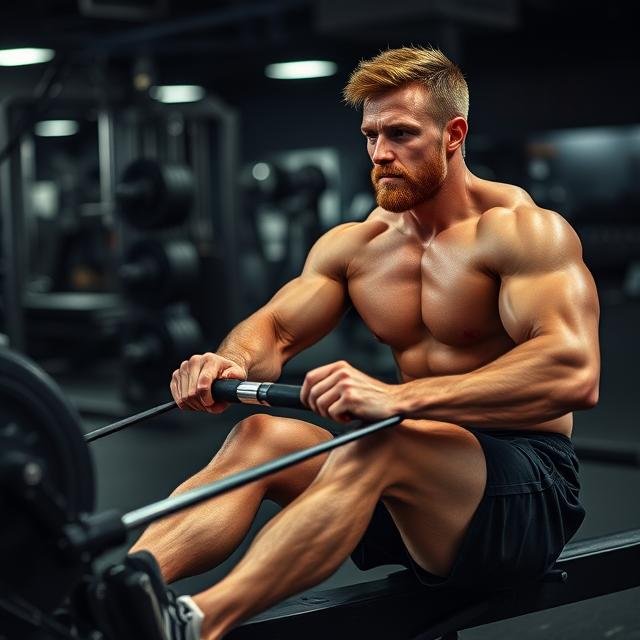
Rowing
Rowing is a full-body, low-impact exercise that combines cardiovascular endurance with strength training, making it an excellent choice for overall fitness. Using a rowing machine or actual boat, the movement involves a coordinated sequence of pushing with the legs, pulling with the arms, and engaging the core to drive the body backward and then returning to the starting position. Rowing effectively targets the legs, back, shoulders, arms, and abdominals while also boosting heart rate and stamina. It’s especially beneficial for improving posture, muscular balance, and endurance without placing excessive stress on the joints. Consistent rowing workouts can enhance both aerobic capacity and muscular strength, making it suitable for beginners and advanced athletes alike.
here are some rowing variations
Improve cardiovascular fitness, strengthens muscles, and builds endurance
1. Rowing Machine (Indoor Rowing)
- Muscles Targeted: Back, legs, core, arms, shoulders, glutes
- How to Perform:
- Sit on the rowing machine with your feet securely strapped in.
- Grab the handle with both hands and sit tall, keeping your back straight and core engaged.
- Begin by pushing off with your legs (the “catch” phase), followed by leaning back slightly and pulling the handle towards your chest.
- Reverse the motion by extending your arms, then leaning forward, and finally bending your knees to return to the starting position.
- Repeat the rowing motion continuously, focusing on smooth, controlled strokes.
- Sit on the rowing machine with your feet securely strapped in.
- Benefits:
- Full-body workout
- Low-impact cardio
- Adjustable resistance (on most machines)
- Full-body workout
2. Concept2 Rowing Machine
- Muscles Targeted: Same as indoor rowing (back, legs, core, arms, shoulders)
- How to Perform:
- This is one of the most popular rowing machines, often used in gyms and rowing competitions.
- It has adjustable resistance based on your stroke rate and intensity.
- The stroke technique is the same as described for indoor rowing.
- This is one of the most popular rowing machines, often used in gyms and rowing competitions.
- Benefits:
- Durable and reliable
- Can track performance metrics like distance, time, and calories burned
- Durable and reliable
3. Barbell Row (Bent-Over Row)
- Muscles Targeted: Upper back, lats, traps, biceps, core
- How to Perform:
- Stand with feet shoulder-width apart and bend at the hips, keeping your back straight.
- Hold a barbell with both hands, palms facing down, and pull the barbell toward your abdomen.
- Lower the barbell slowly, maintaining good form throughout the movement.
- Stand with feet shoulder-width apart and bend at the hips, keeping your back straight.
- Benefits:
- Strengthens the upper back and improves posture
- Can be adjusted for various weights and intensity levels
- Strengthens the upper back and improves posture
4. Dumbbell Row (Single-Arm Row)
- Muscles Targeted: Lats, traps, rhomboids, biceps, shoulders
- How to Perform:
- Start by placing one knee and one hand on a bench for support.
- Hold a dumbbell with your free hand, keeping your elbow bent and close to your torso.
- Pull the dumbbell towards your hip, squeezing the shoulder blade at the top of the movement.
- Lower the dumbbell back down with control, and repeat for both sides.
- Start by placing one knee and one hand on a bench for support.
- Benefits:
- Targets the lats and upper back
- Helps to improve unilateral strength (working one side at a time)
- Targets the lats and upper back
5. Kettlebell Row (Kettlebell Renegade Row)
- Muscles Targeted: Core, shoulders, lats, triceps, chest
- How to Perform:
- Start in a plank position with a kettlebell in each hand.
- Row one kettlebell towards your torso while stabilizing your body with the other arm.
- Lower the kettlebell back to the ground, then repeat with the other arm.
- Start in a plank position with a kettlebell in each hand.
- Benefits:
- Engages the core heavily to maintain balance
- Combines strength and stability training
- Engages the core heavily to maintain balance
6. Seated Row (Machine Row)
- Muscles Targeted: Lats, rhomboids, biceps, traps
- How to Perform:
- Sit on the rowing machine with your feet secured and your hands gripping the handles.
- Keep your back straight, and pull the handles towards your torso by squeezing your shoulder blades together.
- Slowly extend your arms and return to the starting position.
- Sit on the rowing machine with your feet secured and your hands gripping the handles.
- Benefits:
- Isolates the back muscles
- Good for beginners to focus on form without balancing
- Isolates the back muscles
7. TRX Row (Suspension Row)
- Muscles Targeted: Lats, rhomboids, traps, shoulders, biceps
- How to Perform:
- Using a TRX suspension trainer, grab the handles and position your body so that your feet are off the ground at an angle.
- Keep your body in a straight line and pull your chest towards the handles, bending your elbows.
- Lower yourself back down with control and repeat.
- Using a TRX suspension trainer, grab the handles and position your body so that your feet are off the ground at an angle.
- Benefits:
- Engages the core for stability
- Great for improving pulling strength
- Engages the core for stability
8. Inverted Row (Bodyweight Row)
- Muscles Targeted: Back, biceps, core, shoulders
- How to Perform:
- Lie under a bar or suspension system, grabbing the bar with an overhand grip.
- Keep your body straight and pull your chest towards the bar by bending your elbows.
- Lower yourself back down and repeat.
- Lie under a bar or suspension system, grabbing the bar with an overhand grip.
- Benefits:
- Bodyweight exercise, no equipment needed
- Targets the back and biceps while engaging the core for stability
- Bodyweight exercise, no equipment needed
9. Standing Cable Row
- Muscles Targeted: Upper back, biceps, lats
- How to Perform:
- Stand in front of a cable machine with the cable attachment at chest height.
- Hold the handles with both hands and pull them towards your torso, squeezing your shoulder blades together.
- Slowly return the handles to the starting position.
- Stand in front of a cable machine with the cable attachment at chest height.
- Benefits:
- Works the upper back and biceps
- Provides adjustable resistance
- Works the upper back and biceps
10. Reverse Grip Row (Underhand Row)
- Muscles Targeted: Lats, biceps, traps, shoulders
- How to Perform:
- Hold a barbell with an underhand (supine) grip.
- Perform the same motion as a bent-over row, but with your palms facing up.
- Pull the barbell towards your lower chest or stomach, then slowly lower it back.
- Hold a barbell with an underhand (supine) grip.
- Benefits:
- Places more emphasis on the lower lats and biceps
- Helps improve grip strength
- Places more emphasis on the lower lats and biceps
Benefits of Rowing Exercises:
- Full-body workout: Rowing engages multiple muscle groups simultaneously, improving overall strength and endurance.
- Cardiovascular improvement: Rowing improves heart and lung health, offering a great aerobic workout.
- Low-impact: Unlike running, rowing is gentle on the joints, making it a good choice for those with joint issues or for active recovery.
- Calorie burning: Rowing is an effective way to burn calories, making it great for weight loss.
Incorporating different types of rowing exercises into your routine can provide a variety of challenges, target different muscle groups, and prevent workout monotony. Whether you’re using a machine, free weights, or bodyweight, these rowing variations will help you develop strength, endurance, and coordination.
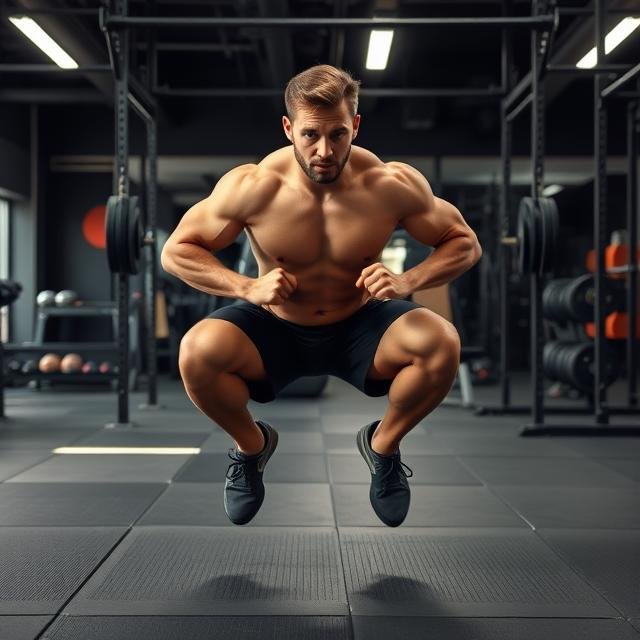
Jump Squat
Jump squats are a powerful plyometric exercise that combines strength and explosive movement to target the lower body, especially the quads, glutes, hamstrings, and calves. Performed by lowering into a squat and then explosively jumping upward, this exercise not only builds muscle and power but also increases heart rate, making it great for burning calories and improving cardiovascular fitness. Jump squats help enhance athletic performance by boosting lower-body explosiveness, balance, and coordination. They can be incorporated into high-intensity interval training (HIIT) or leg-day routines for added intensity. Proper form—keeping the knees aligned, chest up, and landing softly—is key to preventing injury and maximizing results.
jump squats variations
Explosive exercise to improve lower body strength, power, and endurance
1. Basic Jump Squat
- Muscles Targeted: Quads, hamstrings, glutes, calves
- How to Perform:
- Start in a squat position with your feet shoulder-width apart, back straight, and knees bent.
- Push through your heels to jump explosively into the air.
- Land softly with your knees slightly bent, and immediately go back into the squat position to repeat the movement.
- Start in a squat position with your feet shoulder-width apart, back straight, and knees bent.
- Benefits: Builds lower body power and explosiveness.
2. Squat Jump with Hold (Isometric Hold)
- Muscles Targeted: Quads, glutes, hamstrings, calves, core
- How to Perform:
- Begin in a squat position.
- Jump up as high as possible and land softly back into the squat position.
- Hold the squat position for 2-5 seconds before jumping again.
- Begin in a squat position.
- Benefits: Increases time under tension, improving strength and stability in the squat position.
3. Box Jump Squat
- Muscles Targeted: Quads, glutes, hamstrings, calves, core
- How to Perform:
- Stand in front of a sturdy box or platform.
- Perform a squat and then explosively jump onto the box, landing softly with your knees bent.
- Step back down and repeat.
- Stand in front of a sturdy box or platform.
- Benefits: Adds an element of vertical height and depth, focusing on power and coordination.
4. Plyometric Jump Squat
- Muscles Targeted: Quads, hamstrings, calves, glutes, core
- How to Perform:
- Begin in a squat position with your feet shoulder-width apart.
- Explosively jump up, switching the position of your feet mid-air, so you land with the opposite foot forward.
- Repeat the motion continuously, alternating your feet as you jump.
- Begin in a squat position with your feet shoulder-width apart.
- Benefits: Boosts agility, explosiveness, and coordination.
5. Bulgarian Split Jump Squat
- Muscles Targeted: Quads, hamstrings, glutes
- How to Perform:
- Start with one foot on the floor and the other foot resting on a bench or elevated surface behind you.
- Lower into a lunge, keeping the front knee behind the toes.
- Explosively jump, switching legs mid-air so that your opposite leg is forward when you land.
- Start with one foot on the floor and the other foot resting on a bench or elevated surface behind you.
- Benefits: Targets each leg individually, improving single-leg strength and balance.
6. Jump Squat with Dumbbells or Kettlebells (Weighted Jump Squat)
- Muscles Targeted: Quads, glutes, hamstrings, calves, shoulders (if holding weights)
- How to Perform:
- Hold a dumbbell or kettlebell in each hand at your sides or in a goblet position (close to your chest).
- Perform a squat, then jump explosively into the air.
- Land softly and repeat.
- Hold a dumbbell or kettlebell in each hand at your sides or in a goblet position (close to your chest).
- Benefits: Adds resistance to increase muscle activation and power development.
7. Tuck Jump Squat
- Muscles Targeted: Quads, hamstrings, calves, core
- How to Perform:
- Start in a squat position.
- Jump explosively, bringing your knees toward your chest.
- Land softly with knees bent and immediately jump again.
- Start in a squat position.
- Benefits: Improves explosive power and core strength while also focusing on agility.
8. Broad Jump Squat
- Muscles Targeted: Quads, glutes, hamstrings, calves
- How to Perform:
- Begin in a squat position.
- Jump forward as far as possible, landing softly with your knees slightly bent.
- Immediately squat down and jump forward again.
- Begin in a squat position.
- Benefits: Focuses on horizontal power and explosiveness, increasing lower body strength and endurance.
9. Single-Leg Jump Squat
- Muscles Targeted: Quads, hamstrings, glutes, calves, stabilizer muscles
- How to Perform:
- Stand on one leg in a squat position.
- Jump explosively into the air using only that leg.
- Land softly on the same leg and immediately jump again.
- Alternate legs after a set number of reps.
- Stand on one leg in a squat position.
- Benefits: Improves balance, single-leg strength, and coordination.
10. Depth Jump Squat
- Muscles Targeted: Quads, hamstrings, glutes, calves
- How to Perform:
- Start by standing on a raised platform or box.
- Drop down to the ground and land softly, then immediately jump up explosively.
- Start by standing on a raised platform or box.
- Benefits: Develops reactive power and improves the ability to jump quickly from a drop.
Benefits of Jump Squats:
- Explosive Power: Jump squats develop explosive strength, particularly in the legs and glutes.
- Muscle Toning: They target key lower body muscles, helping to build muscle tone.
- Improved Coordination: Jumping and landing with control helps develop better body coordination.
- Calorie Burning: As a plyometric exercise, jump squats elevate your heart rate and burn a significant amount of calories, aiding in fat loss.
Tips for Performing Jump Squats Safely:
- Proper Form: Keep your chest up, back straight, and land softly to avoid knee injury.
- Warm-Up: Make sure to warm up before performing jump squats to prepare your muscles and joints.
- Controlled Landing: Focus on a controlled landing to minimize impact on your knees and joints.
- Progress Gradually: If you’re new to jump squats, start with bodyweight versions and gradually progress to weighted or more advanced variations.